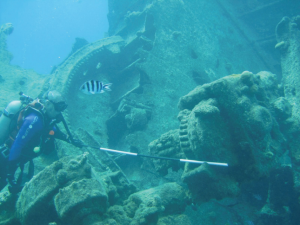
Because the submerged shipwrecks and aircraft wrecks located in Saipan are a significant part of WWII history and draw hundreds of tourists, it is important that appropriate management plans are implemented to ensure the future preservation of these sites. After the heritage trail was developed I returned to Saipan in 2012 for a second project called Management, Monitoring and Interpretive Approaches for WWII Submerged Resources in Saipan (2011-2012). As part of the project, conservation specialists from the Western Australian Maritime Museum (WAMM) conducted the first in situ conservation surveys on 15 WWII wreck sites (10 iron alloy shipwrecks and 5 aluminum alloy aircraft wrecks) located in Garapan and Tanapag Lagoons. The primary focus of these on-site corrosion surveys was to collect data to assist in determining the condition of sites and how they degrade over time. This data provides a baseline for understanding these sites and developing an ongoing monitoring program.

A second in situ conservation survey was conducted five years later in 2017 during the Operation FORAGER project. This project involved the same WAMM team which collected a second set of corrosion survey data to begin a long-term evaluation of the sites. We plan to revisit the sites in 2022 which will give us 15 years of corrosion data. Both projects were funded with the help of the NPS’s American Battlefield Protection Program (ABPP). For more information regarding the in situ conservation surveys in 2017, check out the MUA blog. Information about both projects can be found by looking at the final grant reports 2014, and 2018.
